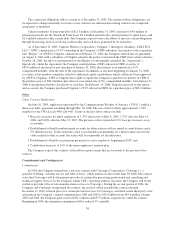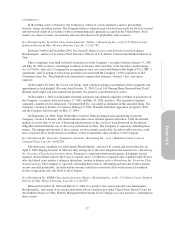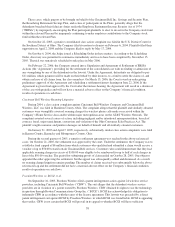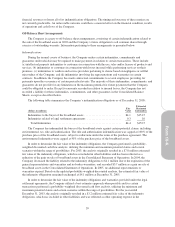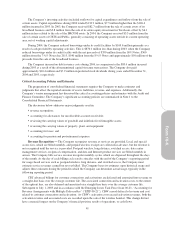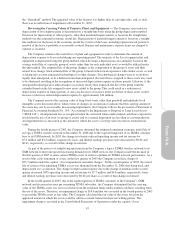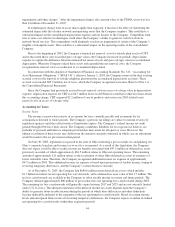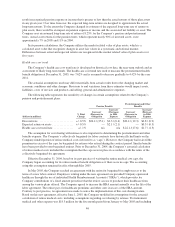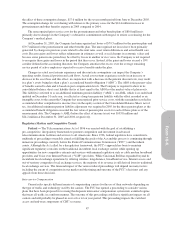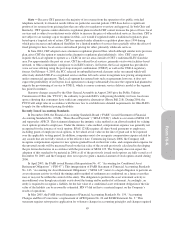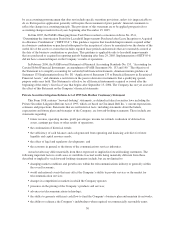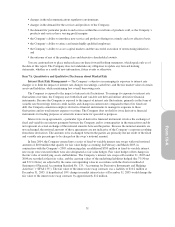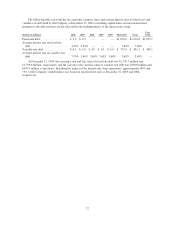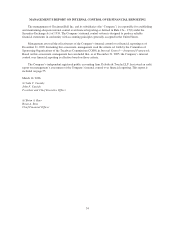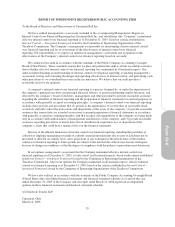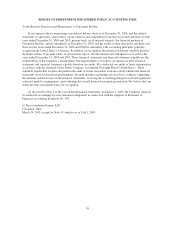Cincinnati Bell 2005 Annual Report Download - page 96
Download and view the complete annual report
Please find page 96 of the 2005 Cincinnati Bell annual report below. You can navigate through the pages in the report by either clicking on the pages listed below, or by using the keyword search tool below to find specific information within the annual report.
result in recognized pension expense or income that is greater or less than the actual returns of those plan assets
in any given year. Over time, however, the expected long-term returns are designed to approximate the actual
long-term returns. To the extent the Company changed its estimate of the expected long-term rate of return on
plan assets, there would be an impact on pension expense or income and the associated net liability or asset. The
Company uses an assumed long-term rate of return of 8.25% for the Company’s pension and postretirement
trusts. Actual asset returns for the pension trusts, which represent nearly 90% of invested assets, were
approximately 7% in 2005 and 11% in 2004.
In its pension calculations, the Company utilizes the market-related value of plan assets, which is a
calculated asset value that recognizes changes in asset fair values in a systematic and rational manner.
Differences between actual and expected returns are recognized in the market related value of plan assets over
five years.
Health care cost trend
The Company’s health care cost trend rate is developed on historical cost data, the near-term outlook and an
assessment of likely long-term trends. The health care cost trend rate used to measure the postretirement health
benefit obligation at December 31, 2005, was 7.62% and is assumed to decrease gradually to 4.42% by the year
2011.
The actuarial assumptions used may differ materially from actual results due to the changing market and
economic conditions and other changes. Revisions to and variations from these estimates would impact assets,
liabilities, costs of services and products and selling, general and administrative expenses.
The following table represents the sensitivity of changes in certain assumptions related to the Company’s
pension and postretirement plans:
% Point
Change
Pension Benefits
Postretirement and Other
Benefits
(dollars in millions)
Increase/
(Decrease) in
Obligation
Increase/
(Decrease)
in 2006
Expense
Increase/
(Decrease) in
Obligation
Increase/
(Decrease)
in 2006
Expense
Discount rate ........................ +/-0.5% $26.4 / (25.1) $0.3 / (0.4) $20.4 / (19.3) $0.8 / (0.9)
Expected return on assets ............... +/-0.5% — $2.1 / (2.1) — $0.3 / (0.3)
Health care cost trend rate .............. +/-1% n/a n/a $22.1 /(17.6) $1.7 / (1.3)
The assumption for cost sharing with retirees is also important to determining the postretirement and other
benefits expense. The Company’s collectively bargained-for labor contracts have historically had limits on the
Company-funded portion of retiree medical costs (referred to as “caps”). However, the Company had waived the
premiums in excess of the caps for bargained-for retirees who retired during the contract period. Similar benefits
have been provided to non-bargained retirees. Prior to December 31, 2004, the Company’s actuarial calculation
of retiree medical costs included the assumption that the caps were in place in accordance with the terms of the
collectively bargained-for agreement.
Effective December 31, 2004, based on its past practice of waiving the retiree medical cost caps, the
Company began accounting for its retiree medical benefit obligation as if there were no caps. The accounting
using this assumption remained in effect through May 2005.
In May 2005, the Company reached an agreement with the union for bargained-for employees as to the
terms of a new labor contract. Employees retiring under the new agreement are provided Company-sponsored
healthcare through the use of individual Health Reimbursement Accounts (“HRAs”), which provides for
Company contributions of a fixed amount per retiree that the retiree can use to purchase their healthcare from
among the various plans offered. The Company agreed to increase the HRA amount annually over the life of the
labor agreement. The retiree pays for healthcare premiums and other costs in excess of the HRA amount.
Contrary to past practice, no agreement was made to waive the implementation of this cost-sharing feature.
Based on this new agreement, effective June 1, 2005, the Company modified its assumptions for the actuarial
calculation of retiree medical costs, including assumptions regarding cost sharing by retirees. Postretirement
medical and other expense was $18.3 million for the five month period from January to May 2005 and including
46


